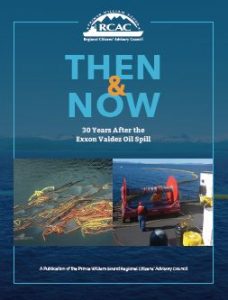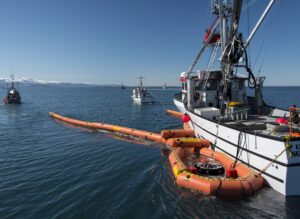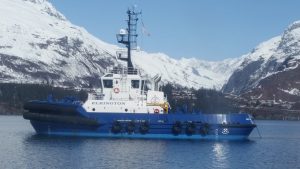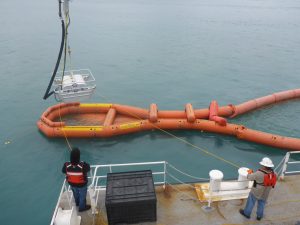NEW: 35 years after Exxon Valdez
How has oil transportation changed in Prince William Sound since 1989?

The immediate cause of 1989 Exxon Valdez oil spill was a navigational error on the part of the tanker’s captain and crew. However, Congress found that complacency among the oil industry and the regulatory agencies responsible for monitoring the operation of the Valdez terminal and vessel traffic in Prince William Sound was also a contributing factor in the disaster.
Few prevention measures were in place and cleanup resources were inadequate.
Since 1989, regulatory agencies, the industry, and citizens have been working together on improved methods to prevent oil spills and how to be better prepared to clean up if another spill should occur.
Laws and Regulations
One of the most important results of the oil spill was the enactment of the federal Oil Pollution Act of 1990, or “OPA 90,” which addressed many deficiencies, including liability, compensation, and oversight. The law required two citizens’ oversight councils, one for Prince William Sound and one for Cook Inlet.
Both federal and state laws now require more comprehensive prevention measures and planning for larger spills and require more spill response equipment to be immediately available.
What has improved in oil spill prevention since the Exxon Valdez oil spill?
Double hulls
All tankers transporting oil through Prince William Sound are now double-hulled. Double hulls, basically two steel skins separated by several feet of space, are an effective design feature which can reduce or eliminate spills that result from groundings or collisions.
Alyeska’s Ship Escort/Response Vessel System

The Ship Escort/Response Vessel System, known as SERVS, was developed after the Exxon Valdez spill. SERVS’ mission is to prevent oil spills by escorting tankers to ensure they navigate safely through Prince William Sound, provide assistance in order to avoid an accident should the tanker experience an engine failure or other malfunction, and to begin immediate response if there is a spill. SERVS maintains a fleet of large escort tugs, keeps trained response crews on duty around the clock, and has spill response equipment ready to respond.
Improved tanker escorts
The system’s powerful tugs escort all loaded tankers from the terminal at Valdez, through Prince William Sound and Hinchinbrook Entrance, and out into the Gulf of Alaska. Two tugs accompany each laden tanker out of Prince William Sound, with one tug tethered to the tanker until it reaches Central Sound where there is more room to maneuver. One tug will stand by at the Entrance to the Sound until the tanker is 17miles out into the Gulf of Alaska.
Risks from human error
All tanker captains, and any crew member suspected of consuming alcohol, are now subject to alcohol tests before sailing. Crews now receive more training and work hours are limited to reduce accidents caused by fatigue.
Monitoring marine traffic
The Coast Guard now monitors the speed and heading of all tankers and other vessels in Prince William Sound through improved radar and the Automatic Identification System. Vessels equipped with this system transmit real-time information about their locations and movements that is made available to the Coast Guard’s Vessel Traffic System offices in Valdez, as well as Council offices, and others.
What has improved in oil spill response since the Exxon Valdez oil spill?
While prevention measures are the best way to avoid environmental damage from oil spills, even the best system cannot remove all risks. Oil spill response in Prince William Sound has seen many improvements since 1989. Alyeska’s SERVS is now considered one of the best oil spill prevention and response forces in the world.

To fulfill their contract, Edison Chouest built nine new tugs and four spill response barges, which represents a significant improvement for the oil spill prevention and response system. In some cases, new general-purpose tugs replaced conventional tugs that were over 40 years old.
Contingency plans
Contingency plans, extensive documents which contain details on preventing and cleaning up oil spills, are required by state and federal law. The requirements in these plans have expanded since 1989 and now must demonstrate that larger spills can be contained and cleaned up with more spill response equipment and trained crews that are immediately available.
Some changes in the contingency plans since 1989 include:
- Local fishing vessels are an integral part of the response plans. The crews, located in the ports of Valdez, Cordova, Whittier, Homer, Seward, and Kodiak, are contracted by Alyeska to respond in the event of a spill, and trained every year in spill cleanup methods.
- More emphasis on shoreline protection and wildlife protection.
- Special strategies have been developed to protect specific areas that have been identified as a sensitive area or a critical resource, such as salmon streams or hatcheries.
Spill response equipment

In 1989, there were only 13 oil-skimming systems in Alyeska’s response inventory; today, 100 units are available. Only 5 miles of oil spill boom were available in 1989; today, over 50 miles of various types of boom are available. Alyeska had only about 220,000 gallons of storage capacity for recovered oil and oily water immediately after the Exxon Valdez spill; today, on-water storage capacity is now over 34 million gallons.
Spill drills
Before 1989, few oil spill drills were conducted in Prince William Sound. Today, three major exercises take place per year, along with several smaller drills. The drills provide opportunities for response personnel to work with equipment and practice procedures.
Improvements at the terminal
For the first twenty years of operations at the terminal, thousands of tons of toxic vapors were emitted annually during the tanker loading process. These harmful vapors threatened the health of the terminal’s workers and Valdez residents. In 1997, Alyeska installed vapor controls at two loading berths, which nearly eliminated the pollution from loading operations.
The Ballast Water Treatment Facility, designed to clean oily residue from tanker ballast water before it is released back into the environment, has also seen improvements. A system has been installed to reduce the vapors released into the environment from the facility. Over the years, emissions from the Ballast Water Treatment Facility have been reduced.
Concerns remain
Although there have been many improvements, there are still many areas of concern, meriting the continued attention and sustained efforts from the Council. A few of these include:
- Complacency: Rollbacks or weakening of state and federal environmental protections.
- Heavy weather operations: The safety of escort tug crews and their ability to respond during strong winds and waves has been questioned due to lack of training in all conditions in which the tugs are expected to operate.
- Response gap: Studies by the Council have shown that it is not possible to effectively clean up an oil spill during the strong winds and waves in which tankers are allowed to transport oil.
- Aging infrastructure: The terminal is over 40 years old and was originally designed for 30 years of service.
Then and Now
Read more about the changes and remaining concerns in our new publication: Then and Now: 30 Years After the Exxon Valdez Oil Spill (PDF)